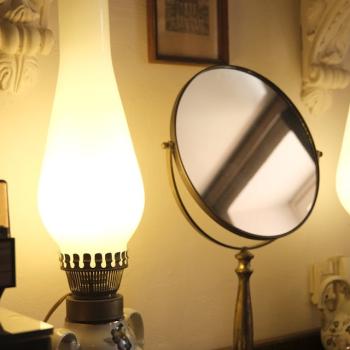Editors' Note: This article is part of the Patheos Public Square on Religion and Visual Art. Read other perspectives here.
Religion — from re-ligare, "to bind together" or "to reconnect" — implies a specific community connected by a shared sense of the sacred. Sacred arts speak to the devoted heart of such a tribe, through images and symbols that make tangible its truths, its revelations, and its joys. Even as the gods create the world, humans make art, and make of art, their offering to the world.
As a contemporary Pagan who is both an artist and a mystic, it is difficult for me to imagine any religious culture without art, especially within the Pagan religions of today. My own art evolved from my need to make tangible expressions of the thoroughly Pagan visions I have experienced since early childhood. Thus, when eighteen years old, I discovered the world of modern Pagan culture and worship and I felt I had found my tribe. What had been a solitary visionary spirituality opened onto a hearth of Pagan religion.
Many modern Pagans value (and make) art, whether or not they identify as artists. Almost all Pagan homes have an altar or a shrine; signs of the sacred are diffused throughout our homes in art and artisan work. For us, arts that speak our spiritual language help create sacred space not only in our homes and temples, but within our minds and hearts. I know of a Goddess statue that has been venerated by the same coven continuously in temple for thirty years; it is now something much more than "only" a work of art. It is alive; something sacred dwells within it.
Here where I live, in "Paganistan" (the greater Minneapolis/St. Paul metro area), elder Steven Posch has identified three essential offerings of our people to the land, the gods, and each other. Every year these offerings are made before the community at large to Minnehaha Falls, considered by many to be the spiritual heart of this region.
The first offering is of water, the blessing of Life. The second offering is of food, the blessing of Sustenance. The third offering is of Beauty. To the Falls, we offer flower petals. To the gods, and each other, we offer beauty in all its forms: flowers, ritual, art.
Art created to express the sacred feeds the hunger of the soul for beauty — not only the beauty that pleases through a harmonious appearance, but also the beauty that challenges, that expresses deeper truths. The world holds darkness and brightness, pleasure, pain, doubt, and peace. All are part of the life journey. To bring forth beauty is to make a worthy offering to the divine.
Our arts venerate the gods and enhance our sense of common connection. All acts of creativity and craft — from cooking styles, sayings and folkways, to story telling, performance and artisan works, to the "purest" fine arts — form the invisible matrix by which our culture teaches itself about itself. Our arts reinforce the field of values in which we participate as a new kind of tribe.
One witch I know wrote runes on every surface of her bedroom before painting over them. These runes cannot be seen: they are hidden. But they are still there: images spoken in signs, blessing prayers. Even when our commonly held spiritual ideas and symbols are not at the forefront of our discourse, they are still present in our understandings with each other and in our art.
Modern Paganism houses many traditions and philosophies, thus re-connection between various people and their practices becomes not a question of believing the exact same things, but of understanding the common ground in which they are rooted. Part of what connects us is that we speak a common metaphorical language. Our symbols speak to each other.
Earth-Sun-Moon-Star-Tree-Sky-Horned-Creature-Fire-Birth-Sacrifice-Death-Renewal... The circle of life, moving on, makes a spiral. We generate metaphors that re-connect us with sacred nature. Rituals honor this connection. Art expresses it.
Someone who does not understand the meaning of a Pagan symbol or metaphorical experience remains an outsider, looking in. Discourse and intellectual argument between faiths can founder on the rocks of polemical differences. Art, on the other hand, presents an invitation to step within the "inner space" of what a spirituality has meant to particular individuals, to connect without conversion. Arts are a means of sharing culture that allows the viewer to learn about the artist's intent while having a completely personal experience at the same time.
I am one of the founders of the Minneapolis Collective of Pagan Artists, which is exploring how our art can serve as a respectful agent of cultural transmission without proselytizing or propaganda. Part of the MCPA's core mission is to present our art as a form of interfaith work: how can we unfold our insider views of Pagan spiritual culture to the larger world? How can we share understanding with those outside the tribe and maintain respect to, and engagement with, those who hold other views?
Our Pagan visions emerge from a rich language of nature-based symbolism, both ancient and modern; from connecting with the world as it is, and how we dream it to be; from myriad manifestations of sacredness and our continual re-connection with them. We value diversity as nature values profusion: such diversity weaves a tapestry of metaphor enriched by spiritual passion. Words are not enough. Perhaps only art can do justice to such a language of the spirit.
2/4/2015 5:00:00 AM




